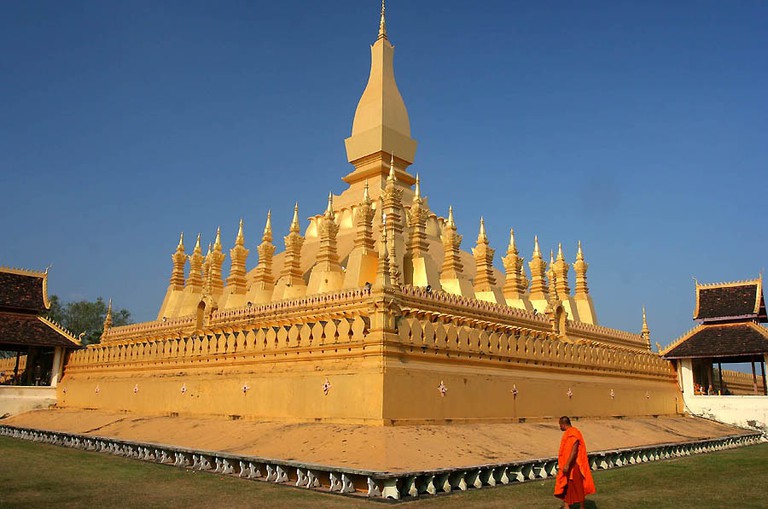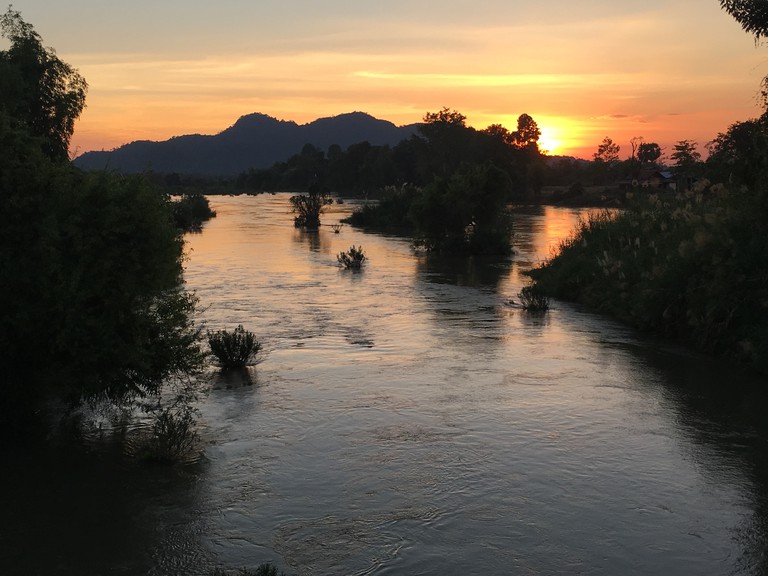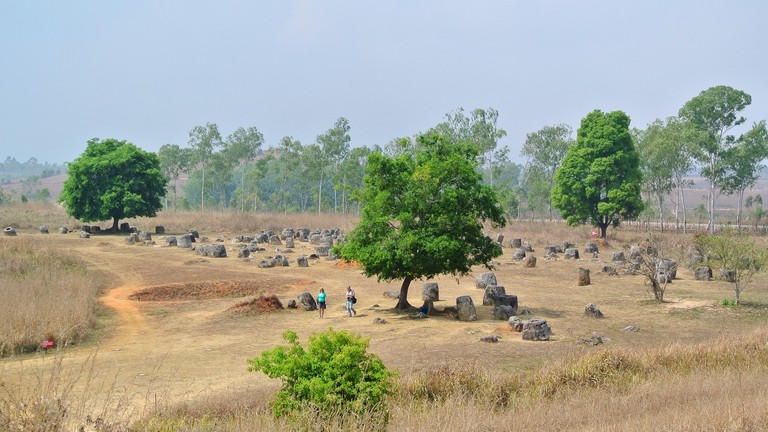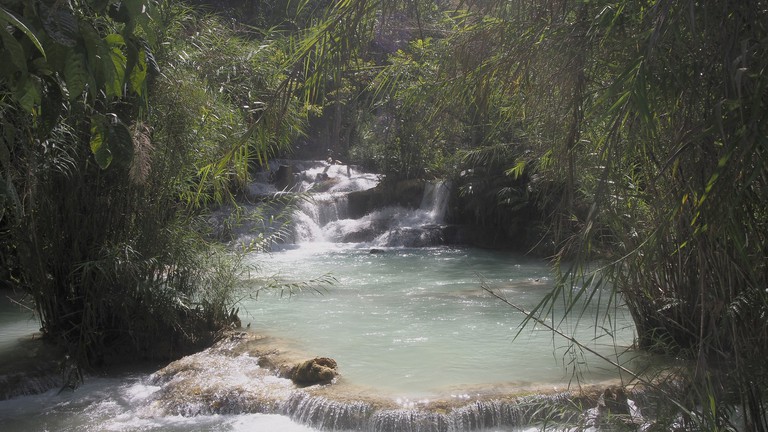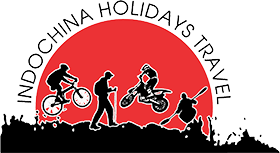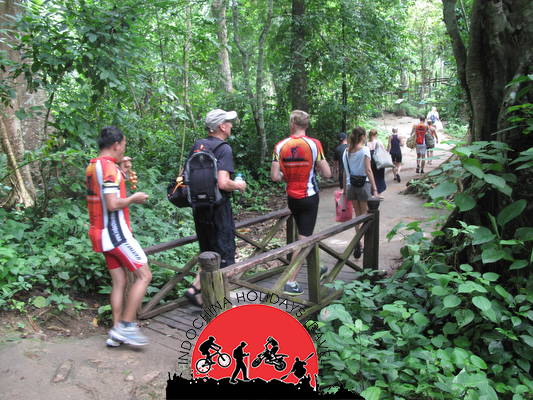Day 1: Hanoi – Arrival
Pick up from the airport to hotel for check in . Free to explore Hanoi by your own .
Summary
Accommodation : ATS Hotel 3*
Day 2: Hanoi – Mai Chau
Have breakfast at your hotel, check out and pick up at 7:30 Am and drive to Luong Son and cycling through Bai Chao villages to Cao Phong – Hoa Binh province. Cycling to Thong Khe Pass . Have lunch on the way then riding on single track through Thai minority villages along Hoa Binh lake . Ride past terraced fields and beautiful valleys. Overnight in a stilt-house of Thai-tribe village . O/N in Poom Coong Village .
Summary
Cycling Distance : 75 km
Meals : Breakfast ,Lunch , Dinner
Accommodation : Home-stay
Day 3: Mai Chau – Pu Luong Nature Reserve – Ngoc Lac
An early morning start cycling from Mai Chau villages and beat the heat of the day. The route takes us away from the river and appears to contour through the same range of mountains that stretch from Mai Chau to Pu Luong Nature Reserve . The road gets more beautiful the closer you ride to Pu Luong with looming karst limestone cliffs and lush vegetation. The route is tarmac all the way, but quite hard riding due to the undulating terrain. Reach to Ho Chi Minh and then transfert to your hotel for check in .
Summary
Cycling Distance : 90 km
Meals : Breakfast , Lunch , Dinner
Accommodation : Gold Time Hotel
Day 4 : Ngoc Lac – Thai Hoa – Tan Ky
An early morning start to beat the heat of the day. The route takes us away from the river and appears to contour through the same range of mountains that stretch from Cam Thuy to Thai Hoa on Ho Chi Minh trails . The road gets more beautiful the closer you ride to Ngoc Lac with looming karst limestone cliffs and lush vegetation. The route is tarmac all the way, but quite hard riding due to the undulating terrain. We ride for the first time on the newly built two lane Ho Chi Minh Highway. It hardly warrants two lanes as there is no traffic! The road makes for smooth fast riding, and for those who prefer there is always the old highway dirt and gravel – that weaves around the new highway allowing for plenty of exploring possibilities along the way.Ride to Muc Son, on the banks of River Song Chu. On the outskirts of this small town are the famous Kan Linh historical relics – a pagoda where the first king of the Ly dynasty, Le Thai To, ruled, in 1428. Continue riding on the trail to Yen Cat. The distance covered today is quite long and there will be the chance to transfer some sections by the back-up vehicle to rest weary legs.There are fewer villages today as the route cuts through forests and jungle. Lunch en route. Overnight Thai Hoa guesthouse. 90+ km.
Summary
Accommodation : Km0 Hotel
Meals : Breakfast , Break , Lunch , Dinner
Cycling distance : 100 Km
Day 5 : Tan Ky - Huong Khe
Continue riding the incredible Ho Chi Minh Trail. Have lunch in Pho Chau town , on the way stop to visit some villages or market. Transfer to Huong Khe town for check in Hotel . Overnight in Huong Khe .
Summary
Accommodation : Duc Tai Hotel
Meals : Breakfast , Break , Lunch , Dinner
Cycling distance : 90 Km
Day 6 : Huong Khe – Phong Nha National Park
Huong Khe the mountains rise and the road winds up, down and along the hillsides. The scenery is spectacular, the road tranquil. Ride up to 80km then transfer the last few km to Phong Nha National Park. The park contains one of the most spectacular caves in Vietnam, It is a true speleological wonder. Visit the cave by boat then wander through the cavern, past the foundations of ancient Cham ruins. Pause to admire the incredible formation of stalactites and stalagmites. Formed approximately 250 million years ago Phong Nha was used as a hospital and ammunition depot during the war, the entrance still showing evidence of fighter aircraft attacks. There are community projects underway with Flora and Fauna International and it may be possible to visit village initiatives and learn more about the forests of the National Park. Overnight at the National Park. 70 km.
Summary
Accommodation : Saigon – Phong Nha hotel
Meals : Breakfast , Break , Lunch , Dinner
Cycling distance : 80 Km
Day 7 : Phong Nha National Park – Khe Sanh
Explore Phong Nha Cave in the early morning by boat . Continue riding on the Ho Chi Minh Trail across the DMZ (better known as the 17th Parallel,) to Cam Lo. The road is now quite flat and makes for good cruising! Stop en route to visit Truong Son Cemetary, a memorial to the tens of thousands of North Vietnamese soldiers who were killed in the Truong Son Mountains along the Ho Chi Minh Trail. Fourteen miles further on is the town of Cam Lo – the Trail here intersects a strategic feeder road (H9) from Dong Ha and at this junction part of the Ho Chi Minh Trail heads across country into Laos. Transfer to Khe Sanh visiting war relics en route. Overnight Hotel in Khe Sanh .
Summary
Accommodation : Green Hotel
Meals : Breakfast , Break , Lunch , Dinner
Cycling distance : 80 Km
Day 8 : Khe Sanh – Dansavanh border – Muangphin
Breakfast 7:30 transfer to Lao Bao border to Cross Lao Bao border from Vietnam meet Lao guide at Lao immigration after immigration formalities start riding from border along road No. 9th, known as Ho Chi Minh trail during Vietnam War. Stop for lunch in a small town of Sepon district, after lunch we continue riding through the Lao tribe villages, the road is flat; we finally reach our destination of a small of Muang Phin where we stay overnight.,This road was strategic road when French attacked Laos and during Indochina war when north Vietnam attacked south Vietnam, communist army from north Vietnam came through Laos to south Vietnam, called Ho Chi Min trail, America dropped a lot of bombs to stopped north Vietnamese army but not success, in 1975 communist took over south Vietnam and Laos land mine scattered around the village and jungles
XEPON: is a pleasant rural stopover for those in transit on the route to Vietnam or Savannakhet. The original town of Xepon was destroyed during the war – along with every house of the district’s two hundred villages and was later rebuilt here 6km west of its original location, on the opposite bank of the Xe Banghiang River. The old city (written as “Tchepone” on some old maps) had been captured by communist forces in 1960 and became an important outpost on the Ho Chi Minh Trail. As such, it was the target of a joint South Vietnamese and American invasion in 1971, aimed at disrupting the flow of troops and supplies headed for communist forces in South Vietnam.,Muang Phin: An imposing Vietnamese-built monument to Lao-Vietnamese cooperation during the Indochina wars stands in Muang Phin, 155km east of Savannakhet and 34km west of Sepon. Done in the stark ‘Heroes of Socialism’ style, the monument depicts North Vietnamese Army (NVA) and Pathet Lao (PL) soldiers waving an AK-47 and Lao flag aloft.
Summary
Distance: 80 km
Meal: B, L, D
Accommodation: Guesthouse
Day 9: Muangphin – Xeno
We have breakfast at a local restaurant arrange by our guide, we continue on road No. 9th head west on direction to Thailand through the hill tribe villages and paddy fields, we stop for lunch at the local restaurant or by the road under the tree, we finally reach our destination in XENO, the cross road to Thailand, Vietnam, south Lao and north Laos, ,SENO was named by French, when French attacked Laos, this junction of small town was the head quarter of French military, to fight with Lao army from Cambodia through the south of Laos, in French S: Sud (south) E: Est (east) N: Nord (north) O: Ouest (west) = SENO
Summary
Distance: 125 km
Meal: B, L, D
Accommodation: Guesthouse
Day 10 : Xeno – Thakhek
After breakfast we turn right head north on road No. 13th south, this road is the main road from China in northern to Cambodia in southern Laos, in southern Laos is lower than northern Laos so the road No. 13th south almost flat. We stop for lunch at local restaurant and keep riding to our destination of old town of Thakhek, after check in hotel you free to explore a small town by the Mekong River, remaining of colonial buildings in the center town,When Vietnamese and Lao leaders, led by Prince Suphānuvong decided to defend the city of Thakhek against French forces. On 21 March 1946, under the command of Jean Boucher de Crèvecoeur, European and Lao troops in the Forces du Laos, supported with artillery and airpower, attacked their adversaries in what was a short-lived but intense urban battle. British-supplied Spitfires wreaked havoc on the Vietnamese–Lao troops as they tried to withdraw from the city under heavy fire and across the Mekong to safety in Thailand. The French opened fire from the banks and sent Spitfires to machine-gun from the air hundreds of boats and pirogues trying to transport troops and civilians to safety across the river in Thailand. Suphānuvong himself was injured while trying to escape .
Summary
Distance: 100 km
Meal: B, L, D
Accommodation: hotel
Day 11: Thakhek – Paksan
After breakfast we ride from our hotel to road No. 13th south, after 8 km we stop at the ancient wall, according to the history, King Sikhotabong build the great wall around town to protect the town from enemy, only some short part remain for new generation most are destroyed for construction. ,We stop for lunch at the local restaurant and ride along the road head north to our destination of Paksan Province.
Summary
Distance: 187 km
Meal: B, L, D
Accommodation: Soumontha hotel
Day 12 : Paksan – Vientiane
After breakfast at your hotel, we start riding from hotel on road No.13 head north to our destination of Vientiane capital; riding today is all flat, the road some time follows the Mekong River that share border to Thailand on the other side, we reach the junction and regroup there, optional riding or transfer to hotel in the center town depending on time we arrive.
Summary
Distance: 145 km
Meal: B, L, D
Accommodation: Vansana hotel or similar
Day 13 : Vientiane – Thalat
We ride from your hotel in Vientiane capital head north to Thalat pass the NamNgum dam, the ride today is all fairly flat from the town is more traffic but no problem for riding, after 30 km from town is less traffic, we ride through the villages and rice fields, we bring lunch pack from hotel and we stop for lunch at the small shop at the village along the way when we fill hungry. There are few short climbs before we reach our destination at Tha Lat. Tha Lat is one district of Vientiane province, no tourist stay overnight in this town except tourist traveling on bicycle, this town is known as Nam Ngum dam, the first dam in Laos operated hydro power for most of the country and also export to Thailand.
Summary
Altitude: Vientiane = 180 m. Thalat = 190 m. ,Ride: 93 km
Meal: B ,L, D
Accommodation: Lon Ngum view resort
Day 14: Thalat – Vangvieng
We have a long ride today and the heat may be the factor so we will want to leave early. We start riding from our hotel to Phonhong district where the road meets road No. 13 north at the junction, we turn to the north direction, after the first 23 km on flat road we cross the range of Phoupanang mountain continue along the route 13 and stop for refreshment every 20 or 25 km. The rest of the ride is along undulating roads all the way to Vangvieng, we stop for lunch by the road under the shade of the tree or at the small shop by the road, the ride today is up and down no big climb, we will reach our destination in Vangvieng in the afternoon, after check in hotel is free to explore the town or take a swim in the river. Vangvieng has a lively traveler’s scene with all the usual accompanying facilities: e-mail, pubs, pizza and many young foreigners. ,Vangvieng locates 155 km north of Vientiane on road 13 north. The town lies along the bank of the Namsong River; the landscape is made up of strange shaped limestone mountains, caved by erosion.
Summary
Altitude: Thalat 190 m. Vangvieng = 280 m,Ride: 100 km
Meal: B, L
Accommodation: Elephant crossing hotel or similar
Day 15 : Vangvieng – Kasi – Hot spring
We can leave Vangvieng after lunch and spend your morning in extra relaxation time in Vanvieng. After lunch we start riding up north to Kasi along route 13 and although there are some short climbs and most rides are easy, the scenery is just beautiful and you should really enjoy stretching your legs. We will stop for refreshments a few times along the way, we expect to reach Kasi in late afternoon, Kasi is a small district of Vientiane province and no tourist in this town.
Summary
Altitude: Vangvieng = 280 m. Kasi = 405 m. ,Ride: 55 km (from Vangvient to Kasi) (75 km from Vangvieng to Hot spring)
Meal: B, L, D
Accommodation: Somchit guesthouse or Hot spring resort
Day 16: Kasi or hot spring – Kewkacham
After breakfast we start riding from our guesthouse up north, after 8 km we start climbing, today is the hardest day of our trip and there are big climbs, after 17 km uphill to a small town of Phoukhoun where the junction turns to Phonsavanh (the plain of jars) we turn left on road 13th north there are more climbs before our destination of Kiawkacham. Kiawkacham is a small village locates on top of the mountain range.
Summary
Altitude: Kasi = 405 m. Kewkacham = 1340 m,Ride: 94 km (Kasi – Kiawkacham) (74 km from hot spring to Kiawkacham)
Meal: B, L, D
Accommodation: guesthouse (primitive with share bath room)
Day 17: Kewkacham – LuangPrabang
Our guide will prepare breakfast. This area is the coldest place in winter time especially in the morning; our riding today is easier than yesterday, as this village locates on top of the hill after 22 km riding downhill from guesthouse to the bottom we climb 13 km to the top then another 13 km downhill to a small town of Xiang Nguen before easy ride to LuangPrabang.
Summary
Altitude: Kewkacham = 1340 m. LuangPrabang = 270 m,Ride: 77 km
Meal: B, L
Accommodation: SalaPrabang hotel or similar
Day 18: LuangPrabang city tour
Today, explore the sublime treasures of Luang Prabang. Rising at dawn to view traditional alms procession of monks passing slowly through town, and afterwards, meeting with monks inside their temple to discuss their way of life, share ideas questions about their impressions of your lifestyle, beliefs, and culture and theirs. ,Also, exploration of the town, strolling by foot and tuk-tuk, through the downtown and riverfront, pausing to explore major temples dating to the 15th century such as Wat Xieng Thong a masterpiece of Buddhist architecture, Royal Palace structures, and French-colonial period buildings, visiting the colorful local market, Phosi, and visiting other sites in town by preference, such as weaving village. Luangprabang is the oldest city in Laos, and before the 16th century it was the capital city of the land of million elephants (Laos). The town is a beautifully preserved and in 1995 it was added to UNESCO`s World heritage list.
Summary
Distance: 30 km (1 way)
Meals: B, L
Accommodation: SalaPrabang hotel or similar
Day 19 : Luang Prabang Departure
Free at leisure until departure time and transfer to the airport for your departure ,End of service

